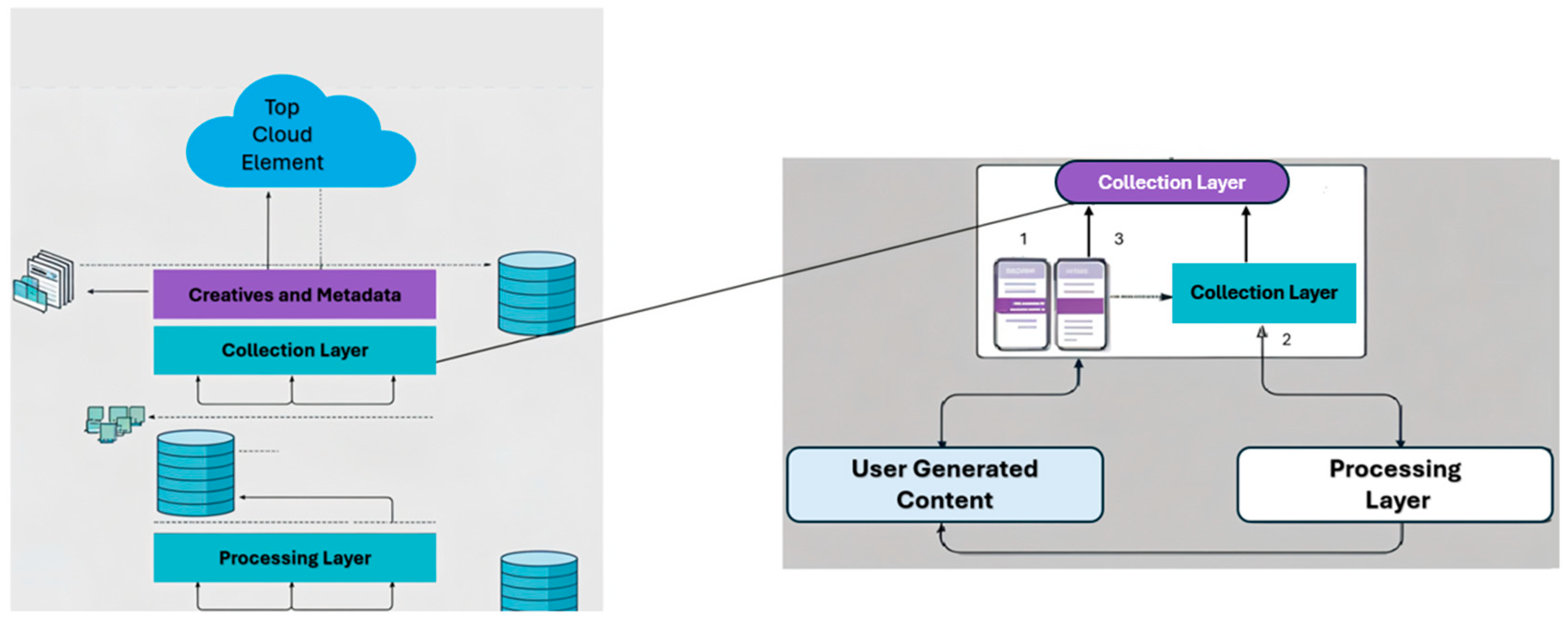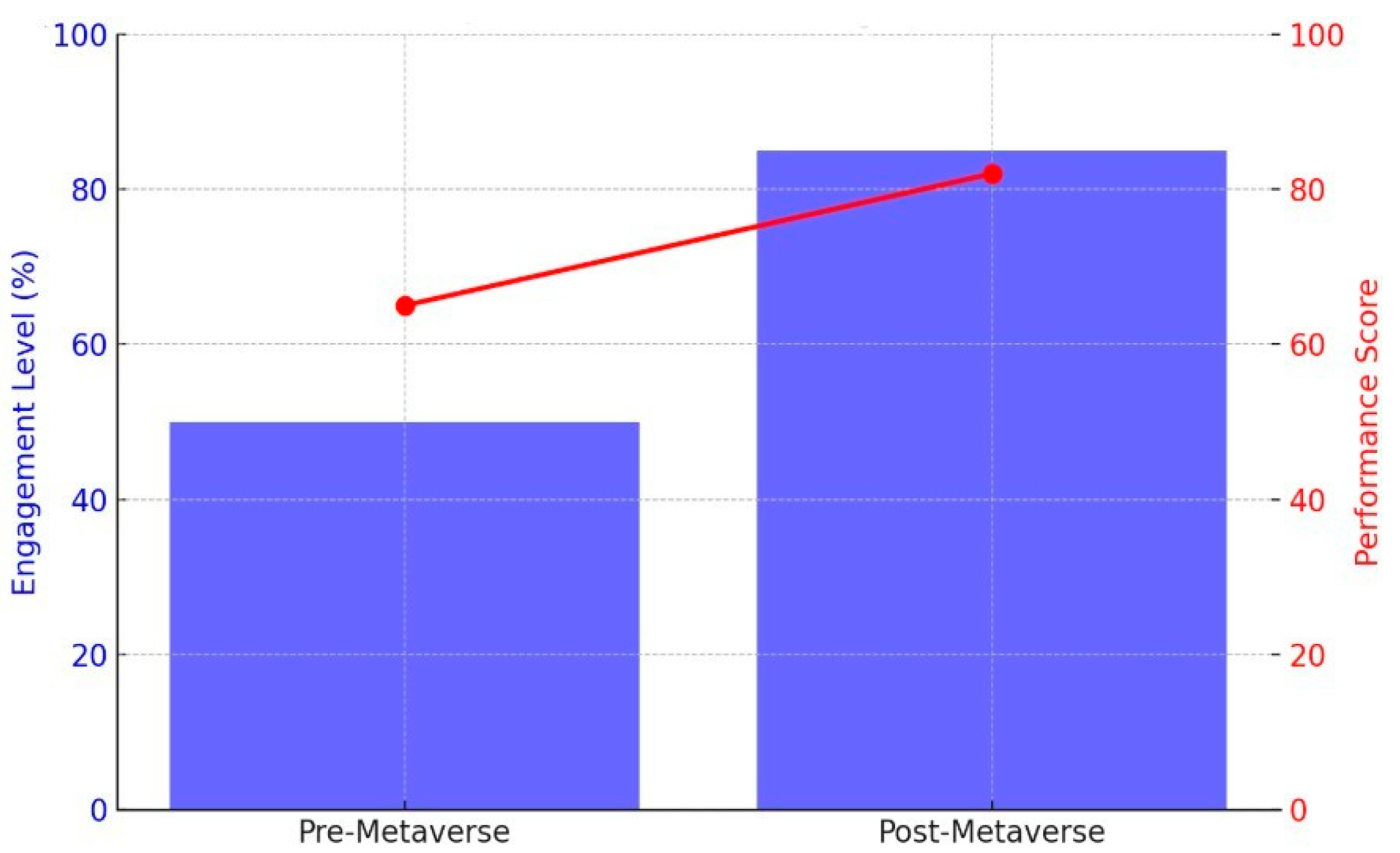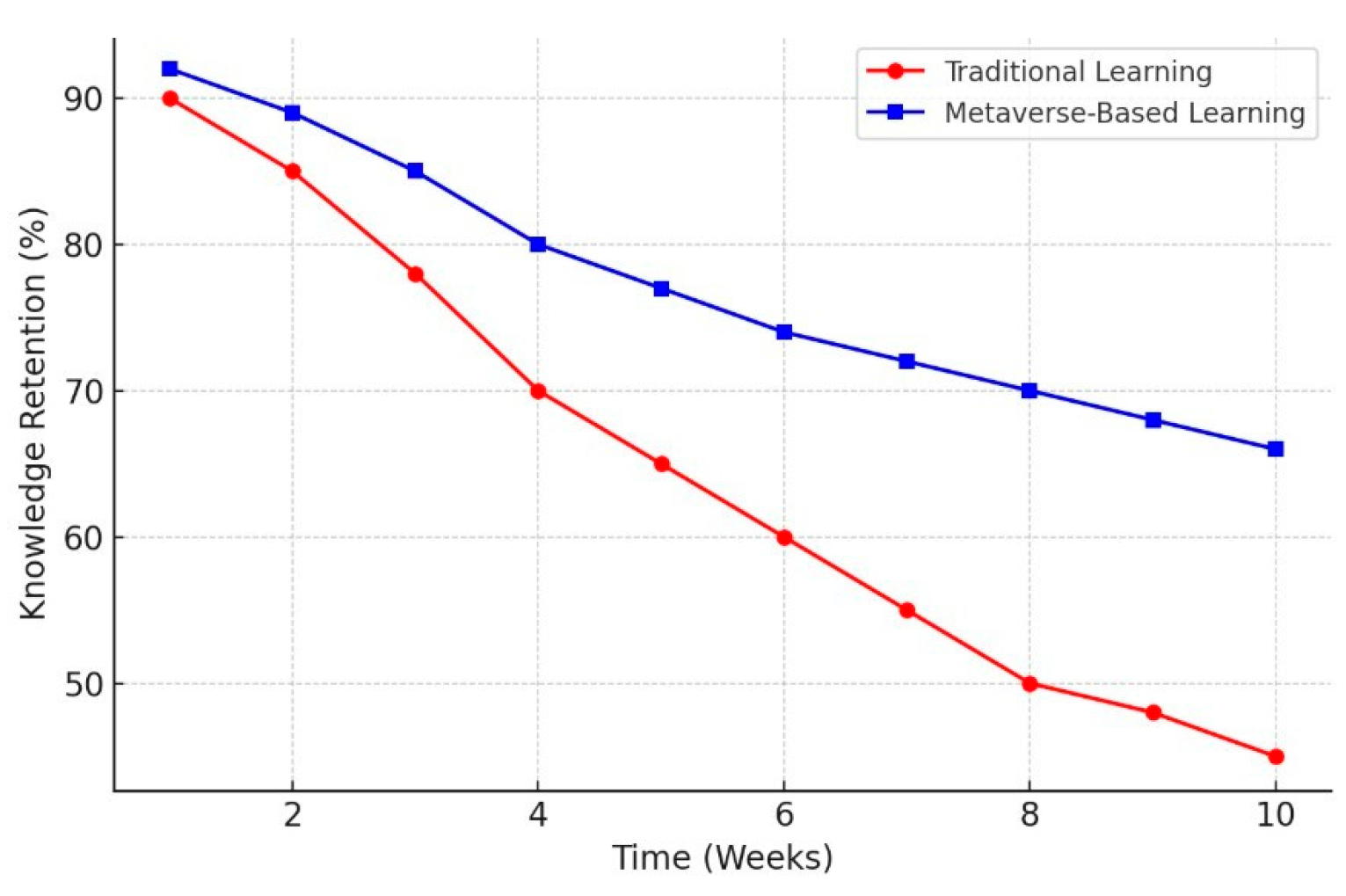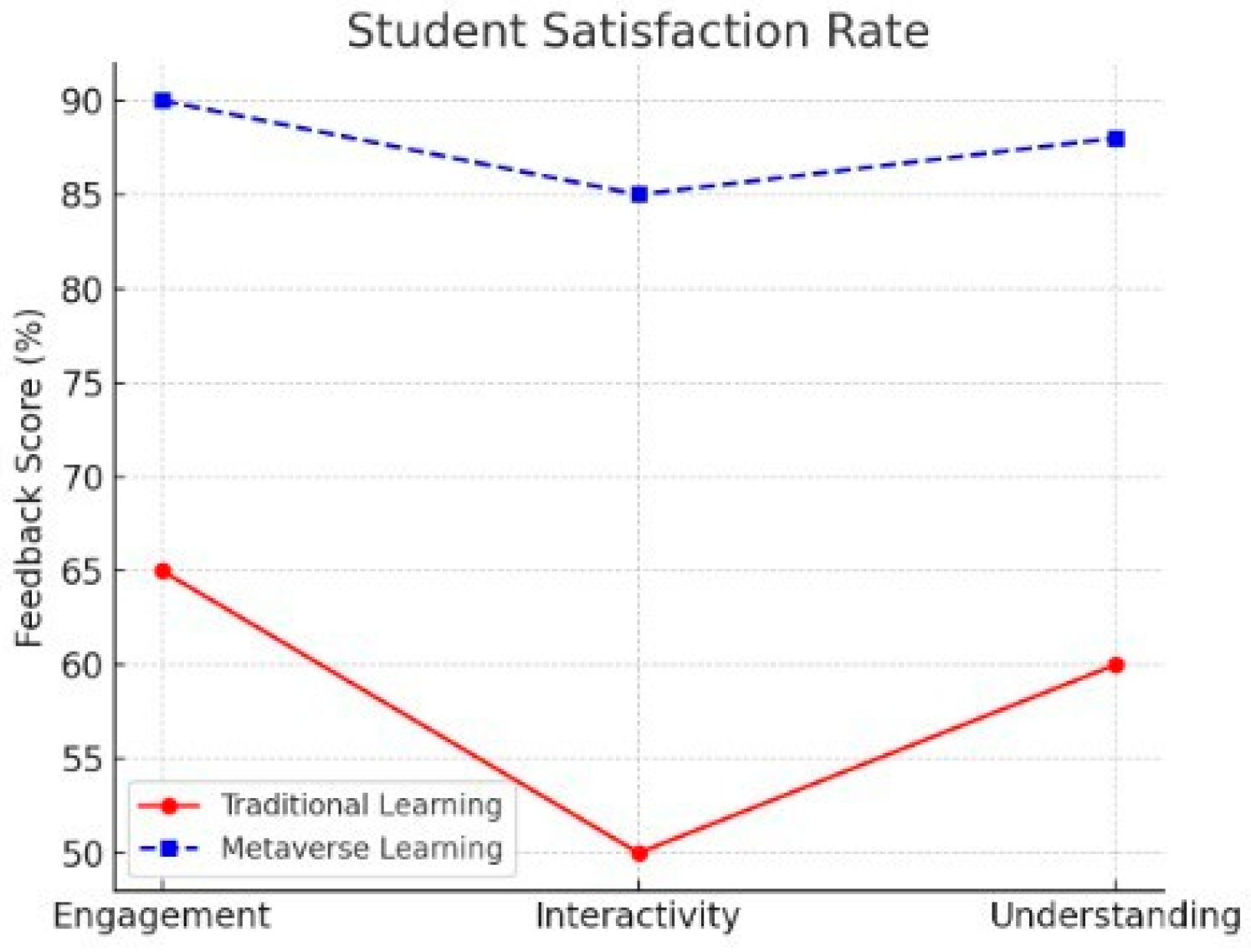1. Introduction
India’s education system has witnessed a major digital shift, especially post-COVID-19. The pandemic broke conventional learning mechanisms worldwide, leaving institutions with no option but to adopt digital platforms to maintain continuity of learning [
1]. In India, this shift was deepened, with more than 360 million students impacted by school closures and reverting to e-learning. However, this transformation also revealed deeply embedded inequalities, e.g., refusal of access to digital hardware and network connectivity, particularly in the countryside. Barring these challenges, the pandemic hastened ed-tech’s adoption in education, presenting the sector with such revolutionary technology as the Metaverse [
2]. The Metaverse is an imaginative development of education technology by way of providing interactive and immersive virtual worlds. As compared to conventional digital learning environments, the Metaverse utilizes technologies such as Virtual Reality (VR), Augmented Reality (AR), and Artificial Intelligence (AI) to provide experiential learning. Learners are able to participate in 3D simulations, virtual laboratory experiments, and virtual classroom learning without being spatially restricted. For example, students from remote locations can be given proper resources and take virtual field trips or conduct scientific experiments that otherwise would have been impossible [
3]. This article discusses the real-world application of Metaverse-based learning in the education system of India. It touches upon key points such as the following:
Technical Architecture: The Metaverse is greatly dependent on future technologies such as 5G/6G networks for ubiquitous connectivity, high-speed data transmission, and low latency. These are paramount in providing immersive experiences and facilitating real-time feedback in virtual schools.
Infrastructural Needs: Deploying the Metaverse needs solid infrastructure such as VR headsets, AR equipment, and hardware-compatible software platforms. This aside, affordability and access are massive challenges in India owing to economic inequalities.
Content Development: Creating interesting and culturally responsive content is one of the key ingredients of successful learning. The Metaverse provides teachers with the ability to design interdisciplinary modules that integrate fields such as science and history in the form of interactive simulations.
Policy Recommendations: Issues of data privacy, equal access to technology, and training teachers need to be addressed by policymakers to make the use of Metaverse-based learning effective.
Challenges: In spite of the huge potential of the Metaverse, it is impeded by the following challenges: high costs of VR/AR devices, absence of digital literacy for students and instructors, and limited infrastructure in rural areas. The capabilities derived from incorporating the Metaverse in education are extensive. They facilitate learning by experience, with greater engagement and understanding of multifaceted topics. For instance, medical students can rehearse surgeries in a risk-free virtual space, while engineering students can jointly design prototypes in 3D environments. Moreover, AI-powered personalized learning within the Metaverse can address individual students and foster inclusivity. But a few major hitches must be ironed out. Restricted access to fast internet and digital technology continues to exclude its uniform adoption throughout India. Additionally, teacher training courses must be overhauled to prepare the instructors with the necessary skills to utilize these cutting-edge technologies effectively.
The Metaverse has the potential to transform India’s education by connecting geographically disparate places and providing new channels of learning. Though there is a massive infrastructure and policy expense in adopting it, the ultimate advantages can make education a more participative, equitable, and accessible process for all students. This paper intends to offer a strategy for tapping the potential of the Metaverse, while navigating the challenges involved, to implement it successfully in the country’s education system.
2. Metaverse Architecture for Education
A Metaverse system for learning brings together several technologies to offer continuous learning. VR and AR are at the forefront of this movement, enabling students to participate in highly interactive simulations. For example, medical students can practice surgery in a VR operating theater, and history students can undergo digital reconstructions of ancient cultures. AR can enhance contextual learning through the projection of digital information onto physical environments, enabling interactive interaction with subjects like science and mathematics [
4].
AI is also central to enhancing learning experiences into personalized experiences. Tutors and teachers driven by AI can track students’ interactions and dynamically change the level of difficulty of instruction, offering personalized instruction to students [
5,
6,
7,
8]. In addition to this, virtual assistants and chatbots can provide round-the-clock academic support, answering queries and disseminating study materials based on the progress of individuals. Blockchain technology offers a secure method of credentialing and authentication, allowing students to receive tamper-proof digital certificates that can be offered to potential employers or educational institutions [
2,
3].
Cloud computing enables scalability and real-time co-working by offering virtual classrooms that integrate students and lecturers from all over the geospatial environment into a shared environment. Learning Management Systems as shown in
Figure 1 is made possible by cloud infrastructure enable institutions to integrate Metaverse tools into virtual environments, exposing students to resources in a seamless fashion [
3,
6].
3. Implementation Methodology
Implementation of a Metaverse-based educational framework is based on a systematic strategy, which involves incorporating state-of-the-art technologies like VR, AI, blockchain, and cloud computing. Infrastructure is built through the deployment of VR headsets such as Oculus Quest or Pico Neo, cloud learning platforms, and fast internet connectivity for smooth interaction. Decentralized architecture provides secure transmission of data and authentication of users through the use of blockchain for credentials’ validation and cloud computing to provide a scalable allocation of resources. Teachers receive extensive training in immersive teaching methods, such as AI-based adaptive learning systems that customize content presentation according to student performance. Students also receive practical training in how to use virtual classrooms and interact with 3D learning environments.
In order to measure the efficacy of the system, a data-driven approach is followed that involves real-time analytics and machine learning algorithms to track engagement rates, academic achievement, and behavioral patterns. Pre- and post-implementation analysis measures gains in knowledge retention, levels of participation, and collaborative problem-solving ability. AI-powered sentiment analysis drives continuous improvement of course content and interaction models through feedback loops. Based on these observations, iterative improvements in VR content, gamification features, and accessibility features are implemented, ensuring an optimized and inclusive digital education environment that can be scaled to institutions across the country.
4. Benefits of Metaverse in Education
There are numerous benefits to implementing Metaverse technology in the classroom. Increasing student interest through interactive, immersive learning is one of the greatest benefits. The Metaverse allows students to participate actively in simulations and hands-on exercises, which enhances retention and understanding. Conventional online learning often has little experiential content. Another important advantage is customized learning, and this is achievable through AI-driven algorithms that adapt content’s presentation to meet the requirements of individual students. AI can provide tailored study material by analyzing learning trends and ensuring that students receive the correct type of assistance and challenge. Secondly, accessibility has increased dramatically, because students from remote areas can now access world-class instruction without the need to relocate. Additionally, the Metaverse fosters collaboration by enabling students to work together in virtual environments, developing teamwork and problem-solving skills. Educational institutions can use blockchain technology to issue secure digital credentials, simplifying the verification of academic achievements for employers and universities.
5. Results
Metaverse-based learning demonstrates a significant advantage in long-term knowledge retention, as shown in
Figure 2. After 10 weeks, students engaged in Metaverse-based education retain 66% of the learned material, whereas those in traditional learning environments retain only 45%. This represents a 21% higher retention rate for Metaverse-based learning, highlighting its effectiveness in sustaining knowledge over time. The immersive and interactive nature of the Metaverse likely contributes to deeper cognitive engagement, making information more memorable and reinforcing learning outcomes.
Figure 3 also supports this finding, showing that Metaverse-based learning consistently outperforms traditional methods in retention over time.
Feedback scores indicate that engagement levels reached 90%, interactivity improved to 85%, and understanding increased to 88%, whereas traditional learning only achieved 65%, 50%, and 60%, respectively as shown in
Figure 4. In addition, the student satisfaction rate highlights a significant improvement in learning experiences with Metaverse-based education, as shown in
Figure 5. These results emphasize that Metaverse learning environments not only improve retention but also enhance students’ overall satisfaction and comprehension.
This suggests that immersive virtual environments provide students with an engaging and interactive platform that enhances their comprehension and active participation in the learning process. The structured and visually appealing nature of the Metaverse fosters an enriched educational experience, leading to higher satisfaction among students. The data also implies that traditional learning methods may lack the interactivity and engagement required to maintain student interest. The notable difference in satisfaction levels indicates that virtual simulations, gamified experiences, and collaborative 3D learning environments contribute to a more enjoyable and effective learning process. This improvement in student perception suggests a paradigm shift towards digital and immersive education as a more preferred mode of learning.
The cognitive load reduction graph shown in
Figure 6 reveals how Metaverse-based learning significantly lowers mental fatigue over time compared to traditional learning. In conventional classrooms, mental fatigue starts at 80% and declines to 55% over 10 weeks, indicating a high initial cognitive burden. Conversely, students engaged in immersive Metaverse-based learning begin with a lower fatigue level of 65%, which further drops to 40%, demonstrating a 25% greater reduction. The findings suggest that interactive and immersive learning environments streamline information processing and minimize cognitive strain by presenting concepts in a more intuitive and engaging manner.
These results support the idea that traditional learning, which relies heavily on passive pedagogy, increases cognitive load and accelerates fatigue. On the other hand, the Metaverse’s interactive and visually stimulating features more evenly distribute cognitive loads, improving memory and reducing stress. Focus and long-term memory recall are enhanced as a result of the gradual decrease in cognitive load, which also helps learners become more accustomed to immersive learning.
6. Challenges and Mitigation Strategies
Despite its potential, the implementation of the Metaverse in education also comes with several challenges. One of the most significant obstacles is the digital divide, as not all students can afford VR devices and high-speed broadband access [
2]. This issue can be addressed through public initiatives such as BharatNet and targeted subsidy programs that provide affordable VR headsets to students from economically disadvantaged backgrounds [
1].
The high cost of implementation is another concern, as developing interactive content and acquiring the necessary hardware requires substantial investment. Public–private partnerships offer a potential solution by leveraging the combined resources of technology companies and educational institutions. In addition, the lack of technical proficiency among teachers poses a barrier to effective implementation. Thus, comprehensive training programs and professional development initiatives are essential to equip educators with the skills needed to effectively integrate Metaverse tools into classroom instruction.
Cybersecurity and data privacy are also critical concerns, given the increased reliance on virtual platforms, which can be vulnerable to cyberattacks. Educational institutions must establish robust security measures, including strong encryption protocols, user authentication systems, and regular security audits, to ensure data protection. By addressing these challenges, the integration of Metaverse technology in education can become more accessible, secure, and sustainable.
7. Conclusions
The Metaverse presents an opportunity to redefine education in India by offering personalized, engaging, and scalable learning experiences. By focusing on infrastructure development, content creation, and cybersecurity, educational institutions can successfully integrate Metaverse-based learning. Public–private partnerships, government initiatives, and educator training programs will be essential for ensuring equitable access and sustainable adoption of this transformative technology.












